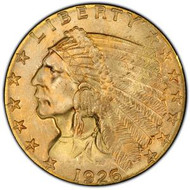$2.50 Indian Gold Coins Are Ripe for Cherry Picking
Posted by Bullion Shark on Jul 18th 2022
$2.50 Indian Gold Coins Are Ripe for Cherry Picking
The Saint-Gaudens $20 and $10 gold coins were introduced in 1907 after years of discussion, design and plaster model creation and production problems, not to mention the controversy about the initial lack of the motto, “In God We Trust". President Theodore Roosevelt’s plan to redesign U.S. coinage then shifted to the two lower denomination gold coins, the $5 and $2.50 coins, or half and quarter eagles.
Originally, the Mint was going to make smaller versions of the Saint-Gaudens double eagle as had been done previously with the Liberty gold coins, but that proved unfeasible because the coin’s large inscriptions would be hard to scale down on the smaller gold coins. While Mint Chief Engraver Charles Barber worked to create a lower relief version of Saint-Gaudens’ $20 coin, a friend of Roosevelt’s, Dr. William Sturgis Bigelow, pursued a different approach.
After returning from a long trip to Japan where he spent most of 1907, in January 1908 he told Roosevelt he was working with a Boston sculptor who had studied with Saint-Gaudens, Bela Pratt Lyon, to create new low denomination gold coins that would be high relief.
A Realistic Indian
Pratt created plaster models for a new design that used Saint-Gaudens’ $10 coin as its inspiration. For the obverse he changed the female wearing Indian headdress who had Greco-Roman facial features to a male Native American chief believed to have been based on a photo of Chief Hollow Horn Bear of the Sioux Nation. This is considered the first time a realistic-looking Native American appeared on U.S. coinage. For the reverse he simply adopted the standing eagle that appeared on the $10 Indian coin Saint-Gaudens created – a design Roosevelt was fond of.
But a key problem, especially with the higher relief versions of the $20 coins Saint-Gaudens created was that they did not stack well, so Pratt instead used an entirely new approach never seen until then on American coinage of recessing the motifs and inscriptions on the coin, or making them incused, so they would stack well and for the artistic novelty as well.
During production, the Mint encountered difficulties striking the new gold coins and had to shave a little of gold off the planchets, which made them thinner than existing gold coins and also meant they would not sort properly with automated sorting machines.
When the coins entered into circulation starting in November 1908, they were criticized by some numismatists as being inferior artistically to the coins of Saint-Gaudens, while others complained that the recessed surfaces would allow more dirt and germs to accumulate. But the public embraced them to a greater extent, giving them as gifts especially at Christmas.
Collecting the Series
This also meant that at the time they were issued, few collectors were saving choice specimens to build sets of the new $2.50 Indian coin, which is why today they are scarce and valuable in high mint state grades. On the other hand, circulated examples, especially in the XF to AU grades, are common for almost every issue of this series except the 1911-D, which is the king of the series with by far the lowest mintage of just 55,680 coins.
These coins were issued from 1908 to 1929, yet it is actually one of the shortest U.S. coin series with just 15 issues in a full set. That is because no coins were issued from 1916 to 1924 because of the scarcity of gold during World War I. Most coins were struck at the Philadelphia Mint except for three that were made in Denver, 1911-D, 1914-D and 1925-D. The most common issues are 1911 and 1913 with respective mintages of 704,000 and 722,000.
The series ended in 1929 because with the onset of the Great Depression, there was no need for the coin in circulation.
Today these coins are widely admired for the originality of the incuse design and the realistic-looking Native American, which has rarely been seen on American coinage. But the coins are mostly acquired as type coins and relatively few people even today are building date and mint mark sets despite the shortness of the series and the fact that unless you are going for high grade pieces, only the 1911-D is costly.
That coin, which comes in two versions – those with a weak D and those with a strong D – is worth at least $1,700 even in VF30 and $2,500 in AU55 and those are prices for the weak variety, which are cheaper! The strong D starts at $3,000 then goes to $6500 in MS60 and in the top grade of MS66 is worth as much as $275,000!
The series also has at least two coins that might quality as potential sleepers, or at least as coins that have some of the lowest mintages of the series that can be purchased through MS60 for the same price as the most common issues. Those are the 1914, whose mintage is 240,000, making it the second-lowest and the 1927, which is third-lowest at 388,000 produced.
Finally, for the type coin enthusiast, an MS60 is just $650, an MS63 $900, MS65 $2,750 but in the top grade of MS67 be prepared to spend $60,000 if you need the best!
And if you are on a tight budget, consider examples that were previously used in jewelry.
Sources:
Q. David Bowers, A Guide Book of United States Type Coins (Whitman, 2019)
Mark Benvenuto, “Indian Head Quarter Eagles,” Numismatic News, April 19, 2022, page 10.


